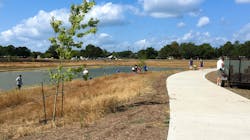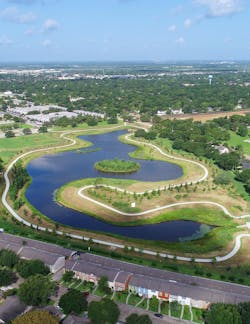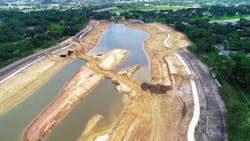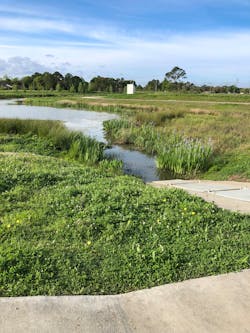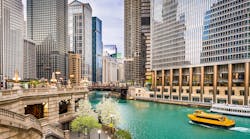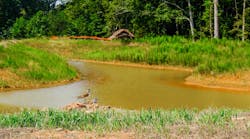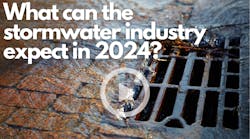The Exploration Green Detention Facility is a project by the Clear Lake City Water Authority (CLCWA) with the goal of reducing area flooding and improving the well-being of the community. The multi-phase green infrastructure project is a series of five wet-bottom detention basins situated on a 178-acre, former golf course. While the project’s goal is to reduce the risk of flooding, it is purposefully designed to provide a host of other benefits that contribute to an enhanced quality of life for area residents. The CLCWA has catered to the community in all aspects of the project: from planning to construction, to Facility operations, to ensure the needs and wants of the community are incorporated.
The project is named ‘‘Exploration Green’’ as a nod to the innovative and exploratory culture of the CLCWA’s service area, which is located adjacent to NASA’s Johnson Space Center. The area was developed in the 1960s and 1970s to provide housing for employees of NASA’s Johnson Space Center, and the Clear Lake City Water Authority was formed in 1963 to provide water, sewer and drainage services to area residents. The project property was initially developed from farmland into a country club and golf course that traversed the adjacent neighborhoods. With more people and development moving into the area, there was increased runoff, and the area became flood prone during storm events. In 2006, when the golf course owner was ready to sell the property, and considering commercial development, concerned community members requested the Clear Lake City Water Authority take action. In 2011, the Authority purchased the 178-acre property for $6 million.
Planning and designing the detention ponds
The Clear Lake City Water Authority had a strategy. It hired SWA to prepare a stormwater master plan and contracted the planning and engineering firm Lockwood, Andrews and Newnam, Inc. (LAN) to design the area-altering project and provide construction administration services. As the designer, LAN was tasked with a dual objective: transform the golf course into a stormwater detention facility, and incorporate elements to the design, which would purposefully make Exploration Green a nature park. Engineers developed a design for five inline, wet-bottom detention ponds. The basins have natural sloping sides, outlet structures, and emergency overflow spillways to control water levels. The detention ponds are interconnected and are designed to work together, providing effective storage, and gradually releasing the collected water at a controlled rate to Horsepen Bayou.
Collectively, the ponds can hold approximately half a billion gallons of stormwater and protect the neighborhoods from flooding, making the area more resilient to storm events. To create each of these large ponds, approximately 2.5 million cubic yards of dirt had to be excavated. Newly installed storm sewers and large box culverts divert runoff from the adjacent neighborhoods into these basins. So now, during heavy rainfalls, the runoff drains from streets more quickly, and empties into the ponds instead of stagnating in neighborhood streets or flooding homes. With completed construction, models for a 100-year storm now project a reduction in the flow of approximately 750 CFS and a water surface reduction of 2.5 inches flowing downstream into Horsepen Bayou.
Green infrastructure elements
In addition to flood mitigation, the facility provides numerous green infrastructure benefits. Chief among them is improved stormwater quality. The detention basins are wet bottom ponds with deep pools that allow for sedimentation. This configuration potentially reduces total suspended solids, contaminants and bacteria from flowing into downstream water bodies, like the ecologically sensitive Armand Bayou Nature Preserve located downstream.
The ponds also incorporate wetland vegetation. Native wetland plants have been installed by volunteers along the fringes of each detention pond’s normal water surface elevation. This vegetation acts as a natural filter, removing pollutants and excess nutrients from the water, ultimately improving water quality. In addition, trash screens are installed and maintained on all outfall structures to filter out waste and prevent the waste from traveling downstream.
The site has been thoughtfully designed and established with native grasses, wildflowers, and trees to provide a natural habitat for various wildlife. This revitalized land, for all practical purposes, has become a nature preserve. The land has been protected under a conservation easement by the Galveston Bay Foundation so that it will never be developed in the future and can remain a green space for generations to come.The design incorporates elements to promote community use and provide a space for the community to gather. There are sports fields and approximately 6 miles of 10-foot wide, ADA-accessible trails. The trails provide safe and accessible routes for area residents to travel off-street to adjacent schools, religious institutions, and the Clear Lake community center. There is also a wetland nursery, located within the facility, which serves as a space for the volunteers to work together to propagate plants for the facility and share with the larger Houston community. In addition, the facility serves as a hub for community events. The Houston Audubon Society holds social events at the facility, and Girl and Boy Scouts have installed troop projects at the site to promote the wildlife habitat and add to the beautification. Recent events held at the facility include Wetland Walkabout and Moth Night, which educate attendees about the native flora and fauna.
Community involvement
Community engagement has been a key to the success of this project. Residents and local businesses have played a significant role in planning, development, fundraising, construction coordination, and supporting facility activities. Early in the project, the Water Authority held public meetings and workshops to gather feedback and provide a formal space where community members could ask questions, voice concerns and provide input. The community’s sentiments were used to shape the master plan and design. During construction, the Water Authority has continued informational updates and ways to communicate thoughts and concerns as issues arise.
In 2014, area residents and the Water Authority board members formed the Exploration Green Conservancy to unify their efforts. The conservancy is a community-based, volunteer-driven nonprofit with an advisory board dedicated to the protection and improvements of the Exploration Green Detention Facility. The conservancy has secured conservation easements and grants to fund the project’s construction. Together, the Water Authority and conservancy have formed partnerships with other environmental and community groups to bolster the enhancement of Exploration Green and the well-being of the community. These community groups aid in site restoration efforts and play a hand in offering education to residents through various programs.A model stormwater plan
Exploration Green Detention Facility is a significant investment in the future of the community. The multi-purpose project not only provides flood mitigation but also environmental improvements, recreation and a native habitat within the heart of the community. The project provides the community an opportunity to have an improved quality of life and increases community resilience. Community engagement has been a key to the success of this project ,and this project serves as a model, demonstrating the potential for transforming abandoned spaces into functional green infrastructure that benefits both the public and the natural environment.
